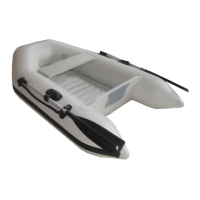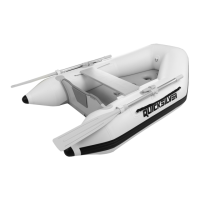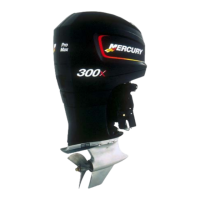FEATURES AND CONTROLS
31
Port Engine Center Engine Starboard Engine
Control Handle
Function
Off (ignition key
switch turned on)
Running
Off (ignition key switch
turned on)
Center engine throttle
and shift = neutral/idle
unless both control
handles are in the
same gear
Turning off one of the outer engines while underway will cause the center engine to go into forced neutral/idle.
Operation to the center engine can be restored by moving the control handle of the functioning outer engine back
into neutral position and then re‑engaging. The center engine speed and gear shift will than be controlled by the
functioning outer engine.
Turning off the center engine while underway will have no effect on the operation of the outer engines.
If a failure should occur while underway which causes a one of the outer engines into forced neutral/idle condition,
the center engine will also be forced to neutral/idle. Operation to the center engine can be restored by moving the
control handle of the functioning outer engine back into neutral and then re‑engaging.
Operation of the shift and throttle is controlled by the movement of the control handles. Push the control handles
forward from the neutral to the first detent for forward gear. Continue pushing the control handles forward to
increase speed. Pull the control handles back from neutral to the first detent for reverse gear. Continue pulling
back to increase speed
Power Trim and Tilt
The outboard has a trim/tilt control called power trim. This enables the operator to easily adjust the position of the
outboard by pressing the trim switch. Moving the outboard in closer to the boat transom is called trimming in or
down. Moving the outboard further away from the boat transom is called trimming out or up. The term trim generally
refers to the adjustment of the outboard within the first 20° range of travel. This is the range used while operating
the boat on plane. The term tilt is generally used when referring to adjusting the outboard further up out of the
water. With the engine turned off and ignition switch turned on, the outboard can be tilted out of the water. At low
idle speed, the outboard can also be tilted up past the trim range to permit, for example, shallow water operation.
a
c
b
3327
a - Trim switch
b - Trim range of travel
c - Tilt range of travel
POWER TRIM OPERATION
With most boats, operating around the middle of the trim range will give satisfactory results. However, to take full
advantage of the trimming capability there may be times when you choose to trim your outboard all the way in or
out. Along with an improvement in some performance aspects comes a greater responsibility for the operator, and
this is being aware of some potential control hazards.
